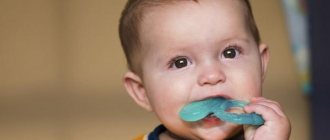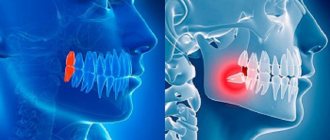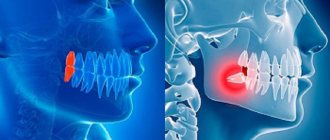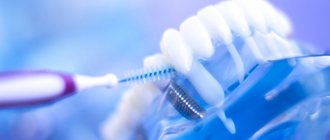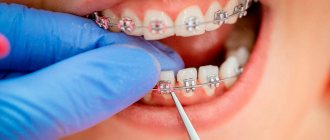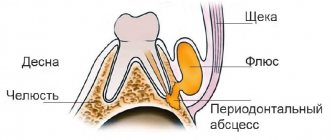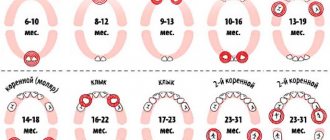The order of eruption of baby teeth
Everyone is different, but it is still important to know how most babies develop. Children's first teeth usually erupt almost simultaneously on the right and left. The sequence is as follows: first the anterior ones (incisors, canines), then the posterior ones.
It is important to understand that this pattern of teething in children is average, and in your case it may happen in a different order or at a different time. This does not necessarily indicate any violations.
Doctors have compiled an approximate, average diagram of teething in children:
Don't worry if you don't meet these standards for several months. If the parents got teeth late, most likely the children will have the same. Heredity has a very strong influence on development. The teething pattern should not become an unnecessary source of parental anxiety. This is just a guideline, like all other norms.
Both the sequence and timing of teething in children can vary greatly. Only if you are “late” by more than 6 months (for example, nothing appears until a year), it is worth discussing this with your doctor. There are genetic disorders when the rudiments of teeth do not develop at all. However, this is extremely rare. Some diseases also affect the timing of teething, but these conditions in children always manifest themselves with some more obvious symptoms.
In any case, there is no remedy that would “cut teeth” - we won’t pull them out of the jaw. We also do not regulate the cutting order. All that remains is to observe the process in children and take care of their health in general.
Teething sequence
Of course, we will talk about the standards according to which the optimal time and order of appearance of the first molars is determined. But don’t be upset if the baby’s personal schedule is behind or in a hurry in relation to this “schedule”. The discrepancy may well reach six months in one direction or the other, so if teeth are already making themselves felt at 3 (three) months, this should not be a cause for concern.
There is the following scheme for the eruption of primary molars:
- 5–7 months - a pair of lower frontal incisors;
- 8–10 months - upper front incisors;
- 10–12 months - a pair of lateral incisors on the upper jaw;
- 11–14 months - lower lateral incisors;
- 12–15 months - first the upper first molars, and then the lower ones;
- 16–23 months - upper, then lower canines;
- 24–30 months - upper, lower second molars.
If the frontal incisors emerge at three months, this is normal, but make sure that the first pair is formed first, and only then, for example, one of the lateral incisors. It is important to immediately rule out pathology in order to take the necessary measures in time.
What problems may arise during teething in infants?
Difficulties do not always arise. But sometimes, about 3 days before and 3 days after teething, the baby’s condition changes:
- gums swell;
- saliva flows more strongly (although a lot of it can be released without connection with teething);
- the temperature rises slightly;
- mood deteriorates (child is less active, cries more often);
- sleep becomes restless;
- stools become slightly looser and more frequent;
- your cheeks turn slightly red (no need to immediately look for allergens and change your diet).
These symptoms may not all appear, in any combination.
The difficulty is that the same symptoms, but usually stronger, can also occur in children with infections. Therefore, if your condition has changed significantly, consult your doctor.
Red flags (tell your doctor if your child has):
- temperature above 38 degrees in the absence of cold symptoms;
- a rash that is unfamiliar to you, which appeared along with a high fever;
- diarrhea, vomiting;
- lethargy;
- mouth ulcers or other sores.
- Eruption cyst (hematoma).
Assess how much the child's condition has changed. If he begins to clearly feel unwell, there is no need to attribute this to the teething of baby teeth. In this case, you need a doctor to rule out more serious problems.
Should I worry?
It is important for parents to understand that the cutting of the first molars is often quite difficult; you should not be afraid of many manifestations. Let's figure out when there is no need to panic, what is the norm. The following symptoms are not considered a cause for concern:
- Copious secretion of saliva. In general, this is typical for most children between 10 weeks and 4 months. Just stock up on bibs and you won't have to worry about hygiene;
- Skin irritation (area around the mouth, chin). This symptom is the result of the same salivation, so do not forget to dry your baby’s skin in time and use an emollient cream before bed;
- Frequent desire to take the breast. This is explained by the desire to scratch the gums; this is normal and should not be denied to the child; it usually goes away pretty soon.
When there is cause for concern
In order for the new molar to erupt as easily as possible, it is necessary to pay a lot of attention to the child; also, each little person has his own pain threshold. Usually the most difficult thing in this regard is the appearance of the very first teeth, as well as the incisors.
Sometimes while breastfeeding, the baby's pain increases so much that he begins to refuse to eat. If you miss 2-3 feedings, you should not worry, but if this number is exceeded, you need to consult a pediatrician.
Also, loose stools are not considered normal; it is caused by excessive salivation during teething. As described above, persistent diarrhea with the appearance of blood should not be underestimated.
What else to pay attention to
It happens that small bumps appear on the gums, that is, a minor hematoma. But you shouldn’t be afraid of this, the formation resolves on its own, cold compresses help a lot.
Sometimes, when the incisors are getting ready to appear, pain also occurs in the chin and ears. The child begins to rub his face or chin, but sometimes this is also a symptom of an inflammatory process in the ear, so a consultation with a specialist will not be superfluous.
A little advice: if the baby is spinning in bed and does not fall asleep, you should not immediately calm the child down, it is better to let him deal with it on his own. You need to pick it up and give it milk when you can’t fall asleep for a long period of time.
Another difficulty is increased salivation, due to which the child begins to cough, and when mucus gets into the nasopharynx, an accompanying runny nose develops. If there are additional symptoms that cause concern, you should contact your pediatrician.
Medicines for teething in children
When your baby is in pain, you would like to have a reliable, effective medicine that you can give and sleep peacefully. As in the case of colic, when teething, the pharmacy will offer you a variety of remedies. Pediatric experts do not advise giving any medications without a doctor's permission.
Why? Homeopathic medicines are divided into true homeopathic (containing no active substance at all, and therefore ineffective) or pseudo-homeopathic. The latter contain some amount of plant components (usually chamomile and other, more exotic plants). The first ones do not work under any conditions, including teething in children, but at least they are harmless. Homeopathic remedies for pain containing belladonna (which was not even always listed in the composition) caused many deaths and were therefore strictly prohibited in developed countries.
In our country, the Commission of the Russian Academy of Sciences recognized homeopathy as a pseudoscience, but, unfortunately, there is no strict ban on potentially dangerous drugs. Since manufacturers do not always indicate belladonna in the composition, we recommend that you generally refrain from using any homeopathic remedies for teething pain in children.
Another case is gels with a local anesthetic drug (their name ends in “-caine”: usually benzocaine or lidocaine). Medicines like these are “freezes” that are injected into the gums when treating teeth. Although these drugs are obviously effective, they have also caused many child deaths. Substances of this group affect the functioning of the heart, because the gel is quickly washed off with saliva, and the child swallows it. It is especially dangerous if the parent uses a higher dose than recommended in the instructions. This happens often because these drugs only relieve pain for a few minutes. When the baby starts crying again, the parents apply more, often exceeding the dose. Now professional communities of doctors do not recommend the use of products with local anesthetics, but this does not stop their widespread advertising.
How and why do teeth appear at 3 months?
It is worth noting that the early formation of bone stone in the oral cavity is a completely normal phenomenon, despite the set time frame for its appearance (6 months). As already mentioned, the appearance of milk formations in the oral cavity depends on many factors.
The main reason for the appearance of bone formation 1-3 months ahead of schedule is the mother’s consumption during pregnancy of certain substances containing vitamins such as D and B, calcium, cheese, curd mass, kefir (all fermented milk products).
Important! Children with early eruption of milk formations must be shown to the dentist at least once every 5 months, since accelerated growth of the dentition most often leads to plaque and caries.
The early appearance of baby teeth requires a thorough examination by specialists, because this can be caused by hormonal disorders and certain pathologies of the child’s mineral metabolism.
The beginning of the formation of a tooth germ is prenatal time.
What to do when children are teething?
The most natural and one of the most reliable ways to reduce pain is cold. Pick up an item - a “rodent” that can be put in the refrigerator. Freezing them is not recommended because it can damage the baby's delicate gums.
Often children prefer to gnaw on their parent's finger or, unfortunately, on their mother's breast. But parents may not have enough patience for a long time, so it is better to find a suitable teether.
It should be:
- whole and durable (the child should not bite off pieces that could cause choking);
- without ropes and beads (the rope can pinch the neck or break, creating a risk of choking on a bead);
- without paint with toxic components;
- just clean (no need to disinfect it).
You can refrigerate the fruit puree or put a few wet cloth toys in the refrigerator so you can replace them.
Of course, children chew not only objects that are ideal for this. But if with a teether made of one piece of silicone or a mitten with a silicone pad the child can be left alone in the playpen for some time, then with a bunch of small objects on a string around the neck or a bracelet made of beads, the same as with some fruit or vegetable, you need to look after it.
If cooling does not help, and the stress of teething is very severe, discuss taking pain relievers and fever reducers (ibuprofen is most often used) with your pediatrician. To be on the safe side, consult your doctor, but a single dose by weight (for ibuprofen is 10 mg/kg), given once at night for 3-4 days of active teething, will not cause harm.
Stages of dentition formation
- First, children begin to develop the lower row of the jaw. Two lower bone formations appear in the middle, which are called central incisors. The period of loss is 6 years.
- The next stage of formation is the top row. There also appear two central teeth, which have the same name as the lower row. The time it takes for them to fall out is 7 years.
- Afterwards, the upper part of the oral cavity is involved. Next to the existing milk teeth, two new ones appear, which are given their own names - lateral incisors. Their growth is felt by some pain in the gums until the middle of its growth, after which these sensations fade. Loss time: 8 years.
- After 2-3 months, the other two teeth appear in the lower part of the mouth. They do not cause pain, only slight discomfort. They become next to the two lower central formations, their name corresponds to the upper ones - lateral incisors. They fall out at different times, depending on the activity towards them. Most often this is a period from 8 to 9 years.
- Further growth occurs most rapidly. Within one year, four milk formations appear at once. Their location in the oral cavity does not correspond to their sequential appearance. They are located like this: two teeth in the upper part of the oral cavity, two in the lower part, through the distance of one bone stone. It looks like four fangs separated from each other. These formations have their own name - the first molars in the upper and lower oral cavity.
- And the last stage is filling in all the missing formations - canines and second molars. Their maturation occurs before reaching 12 years of age.
Should I brush my newly erupted teeth?
Dentists strongly recommend starting to take care of oral hygiene from infancy. For newly emerging teeth, they offer special silicone brushes or wipes. A simpler option is a finger wrapped in gauze. You can simply moisten it with water or use toothpastes for children under 3 years of age (they are marked 0+ and can always be swallowed). The main thing when brushing your teeth is no violence! A little more cleanliness isn't worth the stress.
| Author Fedor Katasonov | Scientific editor Maria Gantman |
Choosing a toothpaste and brush
Has your baby cut his first tooth? Congratulations!
- Until one year of age, parents need to brush their baby’s teeth without toothpaste using a special silicone brush placed on their finger at least once a day.
- At one year old, the baby needs to pick up his first children's toothbrush - without toothpaste for now. It is better if the child chooses it himself. She should interest him, but not scare him away.
What should you pay attention to when choosing a children's toothbrush?
- Decor - kids love bright colors and funny characters.
- The handle should be comfortable, preferably made of non-slip material with a protective ring to avoid injury. Its length should correspond to the age of the child.
- It is important that the brush head is not too large and awkward. The optimal size is 2–3 teeth of a child. To avoid damaging your gums, it is better to choose a brush with a rounded head.
- Soft brushes with a bristle height of no more than 11 mm are suitable for children. It should be even so that the pressure on the surface of the teeth is uniform.
- From 2 to 2.5 years old, it’s time to start using toothpaste and teach your child to brush his teeth on his own. You need to choose a special baby toothpaste without fluoride, because the baby may want to eat it. You can switch to fluoride toothpaste when he learns not to swallow it.
How to help your baby?
Some parents are surprised to notice the presence of the first teeth, while others are faced with all the symptoms described above. If your child needs help, be sure to go to the clinic, where the baby will be examined and you will be advised on further actions.
To alleviate the condition, the pediatrician will prescribe age-appropriate medications (antiviral, antipyretic, and so on).
Gels are very helpful in coping with discomfort and inflammation of the gums during teething. For example, “Dantinorm Baby”, “Kholisa”, “Kalgel”. These drugs relieve pain, relieve inflammation, discomfort, and are endowed with antiseptic properties. But before use you need to consult a doctor.
Teethers: where to buy and how to use?
Buy teethers made from quality materials. To purchase, go to the pharmacy; here you will definitely not buy low-quality Chinese teethers, which can pose a danger to the baby’s health.
Due to the fact that the baby is still poorly able to hold objects in her hands, let’s chew the teether ourselves, from our own hands, and massage the baby’s gums with your finger. Don't forget to wash this item often using antiseptic agents!
There are teethers filled with water or gel. These need to be cooled before use, then they will cool the gums, thereby soothing and relieving discomfort.
Caring for your first teeth
If your teeth appear early, you still need to take care of them! Stores sell special devices for caring for children's teeth, and they look more like a toy than a brush. This device fits onto the parent’s finger and is very convenient for brushing small teeth.
By the time you are one year old, you need to buy a baby brush. The baby does not yet know how to take care of the oral cavity himself, but is already beginning to copy the actions of adults - and this is an excellent reason to start instilling the habit of consistent dental care!
What microelements are needed for teeth growth?
Fluorine
Fluoride strengthens tooth enamel, making it more resistant to acids and harmful bacteria. Thus, it helps prevent the development of caries.
Fluorine is found in:
- Toothpaste - however, remember that toothpaste with a small fluoride content can only be used by children over 4 years old;
- Fluoride-enriched water;
- Chewable tablets or drops;
- Some fruit juices.
Remember that too much fluoride can lead to fluorosis, which is when white spots appear on the teeth. Therefore, it is important not to use too much toothpaste, especially if the child has not yet learned to spit it out.
Calcium
Calcium takes an active part in the mineralization of teeth. A 3-year-old child should receive 800–1100 mg of calcium per day.
Products containing calcium:
- Milk, yogurt;
- Spinach and other green leafy vegetables;
- Broccoli;
- Fish.
In order for calcium to be better absorbed, it needs helpers. One is vitamin D and the other is vitamin K2.
Vitamin K
Calcium is collected and transported into bone tissue using the protein osteocalcin, which normally “dormants” peacefully in the blood. In order to activate it, you need natural vitamin K. It is found in dairy products (milk, yogurt, kefir, cottage cheese - for example, Agusha K2 cottage cheese).


